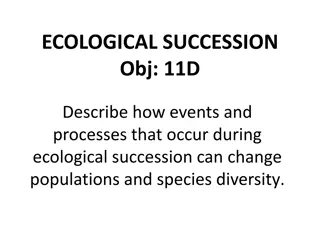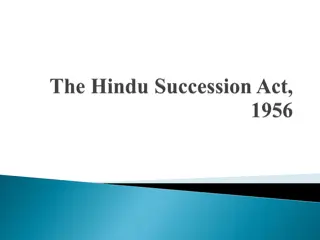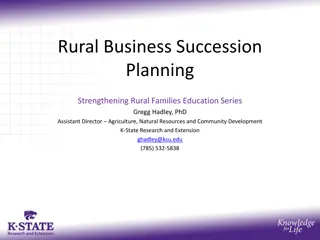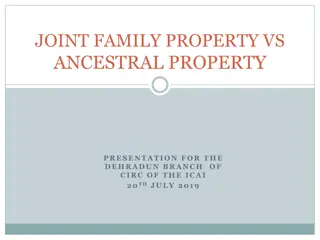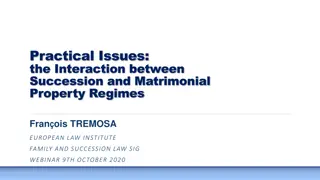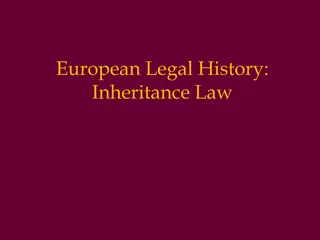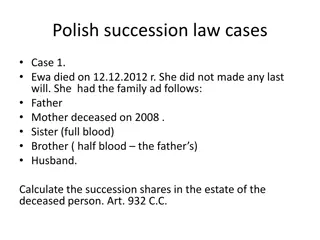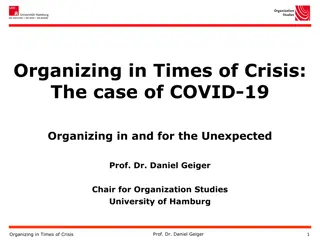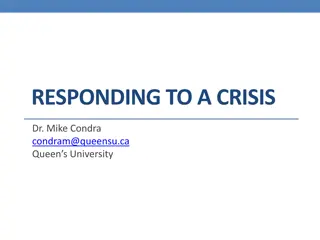The Succession Crisis of 1066: An Overview
England in the 11th century faced a succession crisis in 1066 due to a lack of clear rules for the throne. Edward the Confessor's weak rule led to competing claims from Harold Godwinson, William of Normandy, Edgar Aetheling, and Harald Hardrada. The Battle of Hastings in 1066 saw Harold's defeat by William, leading to William becoming the King of England.
Download Presentation

Please find below an Image/Link to download the presentation.
The content on the website is provided AS IS for your information and personal use only. It may not be sold, licensed, or shared on other websites without obtaining consent from the author. Download presentation by click this link. If you encounter any issues during the download, it is possible that the publisher has removed the file from their server.
E N D
Presentation Transcript
Normans Revision: Topic 1 of 3
The Succession Crisis of 1066 England had rich mineral resources and fertile farming land. England was a Christian country. 1013 the Vikings invaded England and Canute became the first Viking king of England. England was divided into four Earldoms: Wessex, Northumbria, Mercia and East Anglia. The Earls became the most powerful men in England after the king. Summary of England in the 11th Century Topic Summary 1. England had a troubled History in the 50 years leading up to the succession crisis of 1066. Edward was able to become king because the Vikings were losing interest in England. Edward was crowned king on 3rd April 1043. Edward appointed Normans to important posts in his court as he felt he could trust them The Witan (English advisors) did not like this and encouraged the Godwin family to return to England. Edward turned out to be a weak ruler. He focused more on religion. Late 1050s Harold Godwinson was proclaimed sub-regulus 2. There were no clear rules in place for succession to the English throne. 3. Edward the Confessor had been a weak ruler. He increased Norman influence at court and allowed the Godwins to increase their power. 4. Of the four claimants to the throne in 1066 Harold had the strongest position being already virtually in charge of England. However, he faced competition from others who thought they had the right to be king in particular William, Duke of Normandy. The claimants to the throne in 1066 Edgar Aetheling Harald Hardrada (The Viking) Strengths Weaknesses Strengths Weaknesses 5. Harold was hurriedly crowned just one day after Edward s death. The haste reflected how insecure he felt. He knew he would face challenges from other claimants. Was an experienced ruler of Norway A famous Viking warrior Had the support of Harold Godwinson s brother (Tostig) He settled disputes using force His name means hard ruler and that was the approach he took Edward s nearest blood relative His grandfather was named successor in 1056 but died in 1057 He was only 14 years old in 1066 He had no money, soldiers and no military experience How to name a successor English Custom: William, Duke of Normandy (The Norman) Harold Godwinson (Earl of Wessex) The dying King s last words was more important than any promise made before that moment. Strengths Weaknesses Strengths Weaknesses Distant cousin of Edward the Confessor Promised the throne of England after helping Edward defend against the Godwin rebellion Proved himself to be a capable ruler in Normandy Illegitimate son known as William the bastard . The strongest and richest man in England Acted as sub-regulus to Edward during the final years of his life Skillful military leader Edward asked Harold to become king on his deathbed. Attempted to overthrow Edward in 1051 but failed Sword an oath of allegiance to support William s claim to the English throne already Norman Custom Earlier promises of the throne were seen as final and could not be undone, even on the king s deathbed.
Why did William win the Battle of Hastings? Harold Godwinson Vs Harald Hardrada Topic Summary 7) Hardrada and Tostig were both killed. Three days later Godwinson was told William hand landed in the south of England 1. Harold Godwinson became king when Edward died, but he knew that he was likely to face challenges. 1) The English has just lost against the Viking army at the Battle of Fulford Gate The Battle of Stamford Bridge 2) Godwinson marched north with his private army. 6) A lone Viking warrior defended the bridge until he was killed by the Saxons 2. He faced threats from both Harald Hardrada and William of Normandy. 3) Marched 190 miles to York in four days, attacking on the 25th September 1066 4) The Vikings were surprised by the Saxons and had not defended the bridge properly 3. Both William and Harold made extensive preparations for war and both assembled large armies and navies. 5) Many Vikings did not have any armour on due to being surprised by the Saxons Harold Godwinson Vs William Duke of Normandy 4. The Battle of Stamford Bridge was a convincing victory for Harold but Harold s army arrive at Hastings exhausted. The story of the Battle of Hastings The shield wall was disintegrating. The housecarls attempted to shield Godwinson but he was killed. Seeing his death the fyrd broke ranks and fled. The Normans were victorious At midday there was a break from the fighting. William changed his tactics and got his archers to fire straight into the housecarls which caught them by surprise The Norman archers and cavalry attacked the Saxons on Senlac Hill, but were blocked by the housecarls and their shield wall formation The Normans ran away and were chased by the fyrd who became stuck a the bottom of the hill and were slaughtered. This became known as the feigned retreat Wiliam ordered the cavalry to charge. The Normans deployed the feigned retreat again weakening the numbers of fyrds in the Saxon shield wall 5. The Battle of Hastings was a closely fought encounter. 6. The Normans used archers and cavalry, while the English relied on foot soldiers and hand-to-hand fighting. Why did William win the Battle of Hastings? 7. William won the Battle of Hastings due to a combination of superior tactics, better leadership, disciplined troops and luck. Luck William s leadership Harold s weaknesses Other Both Hardrada and William launched their attack at the same time. A number of Harold s best troops were killed during the Battle of Stamford Bridge Some say William s soldier s ran away, which led to the feigned retreat. William delayed his invasion which demoralised Harold s soldiers. William brought all the equipment needed to feed and defend his army. William s troops were organised into divisions with a system of communication. Harold hurried to face William. He could have waited for an extra 20,000 troops. Harold chosen to fight on foot rather than horseback. This made it difficult to communicate with his troops. The invasions happened during harvest season which led to desertions in Harold s fyrd. William gained the Papal Banner so his soldiers believed they had Gods blessing to fight. 8. By winning the battle, William cleared a path to become king, but he had much more work to do to fully secure the English kingdom as his own.
How did William establish control over England? Terror: use of violence to crush rebellions. intimidating people by using soldiers and castles their loyalty. Topic Summary Military Presence: Patronage: giving land and titles to people for Concessions: Compromising with enemies for their support. Legality: show he was the legal and rightful king of England. 1. William took over two months to secure the throne before being crowed king. 1066: William punished the town of Poitiers for their role in killing Normans. Most of the town was brunt and key people were killed. Those who died at Hastings had their land given to Normans who had fought for William. 1068: William besieged the city of Exeter which surrendered to the Normans after 18 days. Harrying of the North: killed Saxons, burnt down their homes, animals and crops. Early revolt of 1075: William took land off earls and beheaded Waltheof to show his power. 1066: William left a garrison of soldiers at Hastings and Dover to defend his position. 1067: William returned to Normandy but took some of his potential enemies with him including Archbishop Stigand. The Normans built castles to defend their positions and collected taxes to pay for them and Norman soldiers. A castle was built in Warwick to stop Earls Edwin and Morcar from rebelling. After defeating the uprising in the north, William built a second castle in York and placed Fitz Osbern in charge. Edgar Aetheling and other senior Saxons swore oaths of loyalty to William at Berkhamsted. English lords who pledge loyalty to William were allowed to keep their lands. William offered the Danes money if they left and stop supporting the Northern Saxons in their rebellion. Paid off many of his followers who wanted to return to Normandy with money from the monasteries. Attempted to ensue their was continuity from Edward s reign. Royal Writs continued to be written in English. Stigand remained as archbishop of Canterbury until 1070 2. William ruled both England and Normandy and had to rely on loyal followers to rule on his behalf. 3. William was able to overcome all the rebellions against him but it was not easy and he had to use a variety of tactics, such as intimidation, patronage and granting concessions. 4. The use of terror in the north was to try to prevent any future rebellion in a troublesome region. Castles Why were Castles Built? 5. William built castles throughout the country to maintain a military presence, particularly in difficult areas, and to intimidate the people in the hope they would not attempt to rebel. Strategic reasons: Symbolic reasons: They housed soldiers who would put down any attempted rebellion in that area. This was enough to deter anyone considering mounting a challenge to Norman rule Castles were a permanent reminder to the Saxons of who was now governing the country. Often houses were torn down to make the castles and the English had to build and pay taxes to maintain them. 6. While the succession to his sons was not without complications, the Normans were secure in their leadership of England. Motte: earth mound (hill) Keep: a tower built on the Motte King William II (Rufus) Sent to England with a letter which gained him the support of Lanfranc. 1087: Crowned King of England. 1088 Bishop Odo plotted a rebellion against Rufus but William of St Calais informed him of the plot. Rufus divided the barons by giving them concessions and the rebellion failed. King Henry I Possible that Henry murdered his brother Rufus. 1105 Henry attacked Normandy and defeated his brother Robert in 1106. Henry I ruled both Normandy and England as his father (William I) had done Bailey: where the troops were stationed Palisade: fence Ditch: make the castle harder to attack



